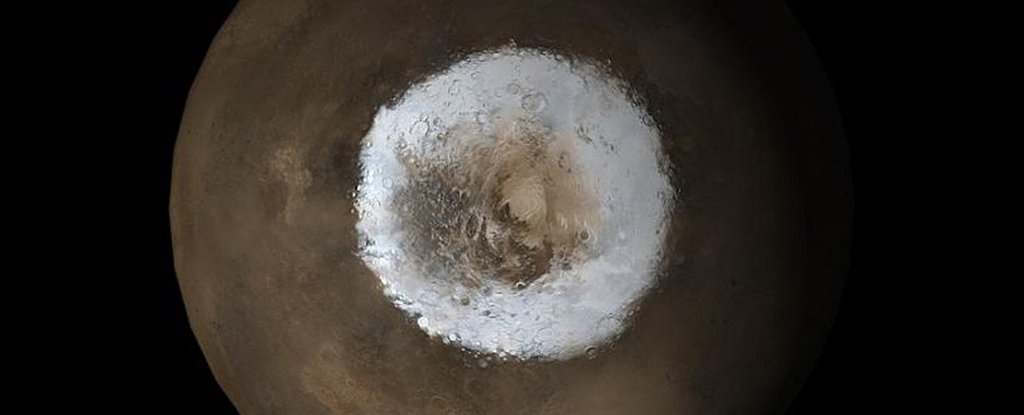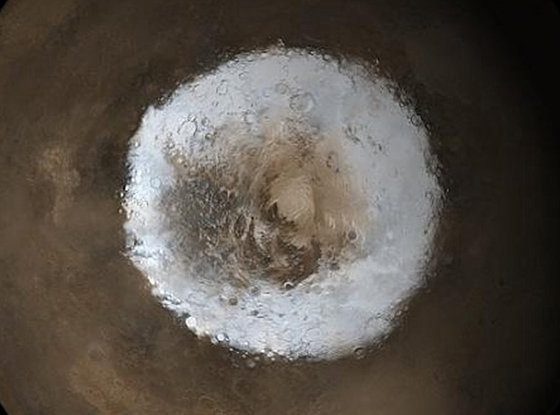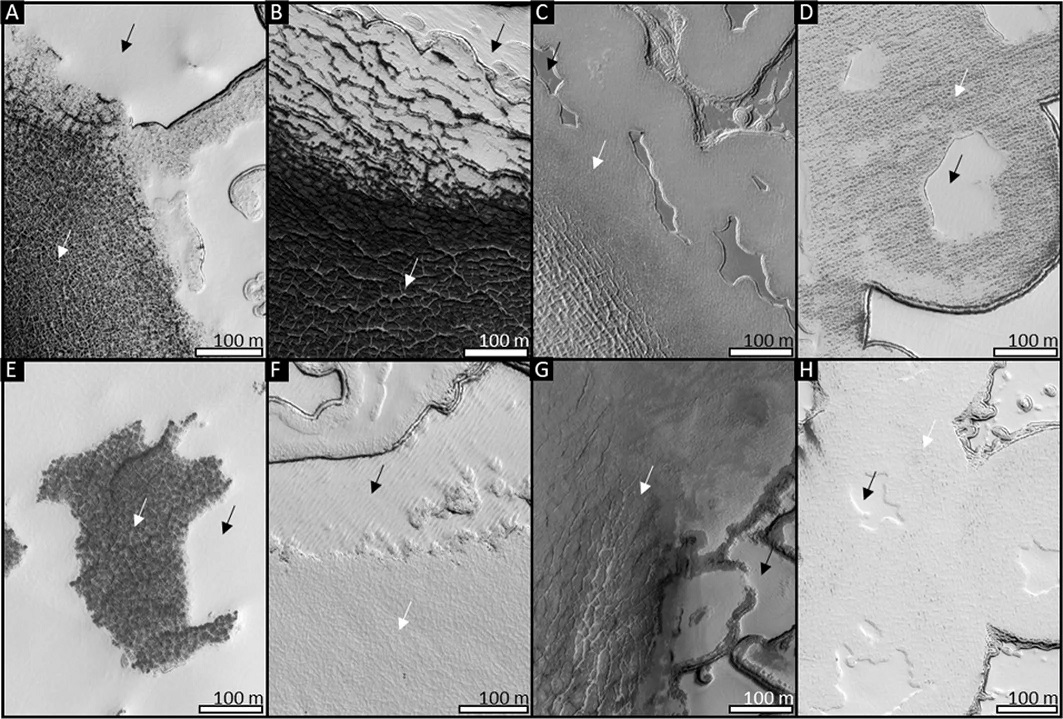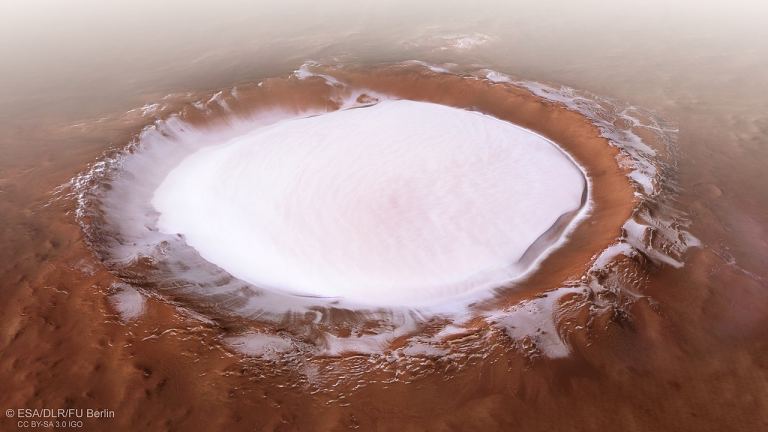

News
Mars’ longtime polar mystery may have finally been solved
From the surface, Mars may seem like a dry, desert-like world lacking water, but a closer look at the planet’s poles will some striking structures: massive polar ice caps.
At the north pole, the ruddy terrain peeks through the ice, like zebra stripes. In the south pole lurks a mystery, a massive deposit of frozen carbon dioxide and water ice. Scientists have spent decades trying to understand how it formed and how it’s linked to the amount of carbon dioxide (CO2) in the Martian atmosphere.
A pair of scientists in the 1960s came up with a plausible theory, and now, decades later, a new study published in Nature Astronomy may have confirmed their findings.

The massive deposit — measuring 3,280 feet (1 kilometer) thick — contains sheets of water ice and carbon dioxide arranged in alternating layers, like a cake. It’s topped off with a thin frosting of carbon dioxide ice, and scientists noticed something interesting: the massive ice deposit contains as much carbon dioxide as the entire Martian atmosphere.
Peter Buhler, a planetary scientist at NASA’s Jet Propulsion Laboratory led the new study. The team used computer simulations to map out the ice, and they were surprised at how closely their models matched with what Robert B. Leighton and Bruce Murray predicted decades ago.
“Usually, when you run a model, you don’t expect the results to match so closely to what you observe,” he said in a statement. “But the thickness of the layers, as determined by the model, matches beautifully with radar measurements from orbiting satellites.”

The ice cap puzzled researchers because according to science, it shouldn’t exist. That’s because water ice is more thermally stable and darker than carbon dioxide ice, which means that it should destabilize when layered between water ice.
However, the new model explains this behavior. Buhler and his team say there are three reasons why the frozen carbon dioxide exists. First, Mars wobbles as it orbits the sun, and when it does, the slight changing of the tilt alters the amount of sunlight that hits the ice. Second, each type of ice reflects the sun a bit differently. And lastly, because of the exposure to sunlight, the carbon dioxide sublimates–meaning it goes directly from a solid to a gas–which alters the atmospheric pressure.
As Mars wobbles, the amount of sunlight reaching the ice varies, causing the ice to form and then later sublimate. When the carbon dioxide ice was forming, water ice would’ve been trapped with it. But when that ice sublimated, the more stable water ice would have remained behind, forming the layers we now see at the south pole.
https://www.youtube.com/watch?v=8Gj8dr6AsYg
Mars’ climate, just like Earth’s, has changed over millions of years. To that end, not all of the carbon dioxide ice was lost; some were left behind to build up the varying layers we see—a process that has altered the red planet’s atmospheric pressure.
This is what Leighton and Murray hypothesized back decades ago, and this is what Buhler’s new model shows.
“Our determination of the history of Mars’s large pressure swings is fundamental to understanding the evolution of Mars’s climate, including the history of liquid water stability and habitability near Mars’s surface,” Buhler said in a statement.
By understanding what processes formed the south polar ice cap, scientists can better understand more of what happened in Mars’ history.

Elon Musk
Elon Musk’s X will start using a Tesla-like software update strategy
The initiative seems designed to accelerate updates to the social media platform, while maintaining maximum transparency.

Elon Musk’s social media platform X will adopt a Tesla-esque approach to software updates for its algorithm.
The initiative seems designed to accelerate updates to the social media platform, while maintaining maximum transparency.
X’s updates to its updates
As per Musk in a post on X, the social media company will be making a new algorithm to determine what organic and advertising posts are recommended to users. These updates would then be repeated every four weeks.
“We will make the new 𝕏 algorithm, including all code used to determine what organic and advertising posts are recommended to users, open source in 7 days. This will be repeated every 4 weeks, with comprehensive developer notes, to help you understand what changed,” Musk wrote in his post.
The initiative somewhat mirrors Tesla’s over-the-air update model, where vehicle software is regularly refined and pushed to users with detailed release notes. This should allow users to better understand the details of X’s every update and foster a healthy feedback loop for the social media platform.
xAI and X
X, formerly Twitter, has been acquired by Elon Musk’s artificial intelligence startup, xAI last year. Since then, xAI has seen a rapid rise in valuation. Following the company’s the company’s upsized $20 billion Series E funding round, estimates now suggest that xAI is worth tens about $230 to $235 billion. That’s several times larger than Tesla when Elon Musk received his controversial 2018 CEO Performance Award.
As per xAI, the Series E funding round attracted a diverse group of investors, including Valor Equity Partners, Stepstone Group, Fidelity Management & Research Company, Qatar Investment Authority, MGX, and Baron Capital Group, among others. Strategic partners NVIDIA and Cisco Investments also continued support for building the world’s largest GPU clusters.
News
Tesla FSD Supervised wins MotorTrend’s Best Driver Assistance Award
The decision marks a notable reversal for the publication from prior years, with judges citing major real-world improvements that pushed Tesla’s latest FSD software ahead of every competing ADAS system.

Tesla’s Full Self-Driving (Supervised) system has been named the best driver-assistance technology on the market, earning top honors at the 2026 MotorTrend Best Tech Awards.
The decision marks a notable reversal for the publication from prior years, with judges citing major real-world improvements that pushed Tesla’s latest FSD software ahead of every competing ADAS system. And it wasn’t even close.
MotorTrend reverses course
MotorTrend awarded Tesla FSD (Supervised) its 2026 Best Tech Driver Assistance title after extensive testing of the latest v14 software. The publication acknowledged that it had previously criticized earlier versions of FSD for erratic behavior and near-miss incidents, ultimately favoring rivals such as GM’s Super Cruise in earlier evaluations.
According to MotorTrend, the newest iteration of FSD resolved many of those shortcomings. Testers said v14 showed far smoother behavior in complex urban scenarios, including unprotected left turns, traffic circles, emergency vehicles, and dense city streets. While the system still requires constant driver supervision, judges concluded that no other advanced driver-assistance system currently matches its breadth of capability.
Unlike rival systems that rely on combinations of cameras, radar, lidar, and mapped highways, Tesla’s FSD operates using a camera-only approach and is capable of driving on city streets, rural roads, and freeways. MotorTrend stated that pure utility, the ability to handle nearly all road types, ultimately separated FSD from competitors like Ford BlueCruise, GM Super Cruise, and BMW’s Highway Assistant.
High cost and high capability
MotorTrend also addressed FSD’s pricing, which remains significantly higher than rival systems. Tesla currently charges $8,000 for a one-time purchase or $99 per month for a subscription, compared with far lower upfront and subscription costs from other automakers. The publication noted that the premium is justified given FSD’s unmatched scope and continuous software evolution.
Safety remained a central focus of the evaluation. While testers reported collision-free operation over thousands of miles, they noted ongoing concerns around FSD’s configurable driving modes, including options that allow aggressive driving and speeds beyond posted limits. MotorTrend emphasized that, like all Level 2 systems, FSD still depends on a fully attentive human driver at all times.
Despite those caveats, the publication concluded that Tesla’s rapid software progress fundamentally reshaped the competitive landscape. For drivers seeking the most capable hands-on driver-assistance system available today, MotorTrend concluded Tesla FSD (Supervised) now stands alone at the top.
News
Elon Musk’s Grokipedia surges to 5.6M articles, almost 79% of English Wikipedia
The explosive growth marks a major milestone for the AI-powered online encyclopedia, which was launched by Elon Musk’s xAI just months ago.

Elon Musk’s Grokipedia has grown to an impressive 5,615,201 articles as of today, closing in on 79% of the English Wikipedia’s current total of 7,119,376 articles.
The explosive growth marks a major milestone for the AI-powered online encyclopedia, which was launched by Elon Musk’s xAI just months ago. Needless to say, it would only be a matter of time before Grokipedia exceeds English Wikipedia in sheer volume.
Grokipedia’s rapid growth
xAI’s vision for Grokipedia emphasizes neutrality, while Grok’s reasoning capabilities allow for fast drafting and fact-checking. When Elon Musk announced the initiative in late September 2025, he noted that Grokipedia would be an improvement to Wikipedia because it would be designed to avoid bias.
At the time, Musk noted that Grokipedia “is a necessary step towards the xAI goal of understanding the Universe.”
Grokipedia was launched in late October, and while xAI was careful to list it only as Version 0.1 at the time, the online encyclopedia immediately earned praise. Wikipedia co-founder Larry Sanger highlighted the project’s innovative approach, noting how it leverages AI to fill knowledge gaps and enable rapid updates. Netizens also observed how Grokipedia tends to present articles in a more objective manner compared to Wikipedia, which is edited by humans.
Elon Musk’s ambitious plans
With 5,615,201 total articles, Grokipedia has now grown to almost 79% of English Wikipedia’s article base. This is incredibly quick, though Grokipedia remains text-only for now. xAI, for its part, has now updated the online encyclopedia’s iteration to v0.2.
Elon Musk has shared bold ideas for Grokipedia, including sending a record of the entire knowledge base to space as part of xAI’s mission to preserve and expand human understanding. At some point, Musk stated that Grokipedia will be renamed to Encyclopedia Galactica, and it will be sent to the cosmos.
“When Grokipedia is good enough (long way to go), we will change the name to Encyclopedia Galactica. It will be an open source distillation of all knowledge, including audio, images and video. Join xAI to help build the sci-fi version of the Library of Alexandria!” Musk wrote, adding in a later post that “Copies will be etched in stone and sent to the Moon, Mars and beyond. This time, it will not be lost.”








